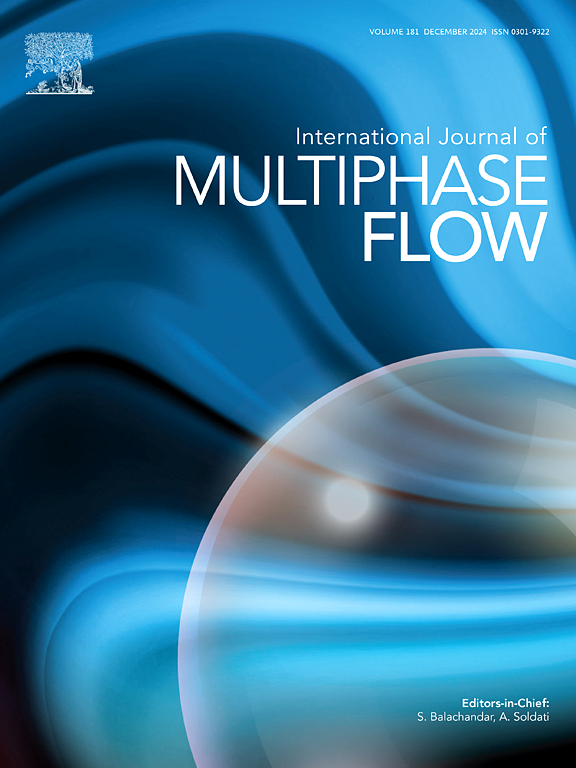A numerical study of ellipsoidal particle interactions and droplet streams with shape oscillations
IF 3.6
2区 工程技术
Q1 MECHANICS
International Journal of Multiphase Flow
Pub Date : 2025-05-21
DOI:10.1016/j.ijmultiphaseflow.2025.105290
引用次数: 0
Abstract
Two-phase flows are studied in both Eulerian-Eulerian and Eulerian-Lagrangian approaches, focusing on linear arrays of particles and droplets, both ellipsoidal and spherical, both in contact and non-contacting. In the first part of this study, the drag coefficients for a stagnant array of particle pairs with different ellipsoidal aspect ratios and different separation distances in an air flow are determined in Eulerian Computational fluid dynamics (CFD) simulations at steady state. From the steady state simulations (first type of simulations), new correlations for the drag coefficients of the leading and trailing droplets in a pair are obtained. Such correlations could potentially reveal the ratio of the drag coefficients of the ellipsoidal droplets in the stream to that of an isolated ellipsoidal droplet. In the second part of this study, transient discrete phase model (DPM) simulations of the grouping process in monodisperse streams of isopropanol droplet pairs in initially stagnant air are presented, utilizing Eulerian-Lagrangian modeling. For these simulations, a drag coefficient model is supplied initially. The usage of the drag coefficients obtained in the steady state Eulerian simulations (first type of simulations) for the subsequent transient DPM simulations (second type of simulations), is justified by the viscosity ratio between the droplet liquid and the ambient air, which is 131. For high viscosity ratio and low Weber number, the drag coefficient of a viscous sphere is similar to that of a solid sphere. Using these drag correlations from the first part of this study in transient DPM simulations of spherical droplets and oscillating droplet shapes in the second part, a slight decrease in collision time was observed for the oscillating droplets relative to the spherical droplets. Larger initial droplet velocity and smaller initial distance between droplets in a pair were found to increase the collision time difference between ellipsoidal and spherical droplets. These results coincide with the DNS results reported recently. Two mechanisms of grouping enhancement due to droplet shape oscillations are suggested. The first is the negative drag coefficient of the trailing droplet at specific geometries, which can be regarded as a weak attraction between the droplets. The second is the distance between the droplet centers at the collision time, which can either promote or delay coalescence.
具有形状振荡的椭球粒子相互作用和液滴流的数值研究
用欧拉-欧拉和欧拉-拉格朗日两种方法研究两相流,重点研究颗粒和液滴的线性阵列,包括椭球和球形,接触和非接触。在本研究的第一部分中,通过欧拉计算流体力学(CFD)稳态模拟,确定了具有不同椭球长径比和不同分离距离的停滞粒子对阵列在气流中的阻力系数。从稳态模拟(第一类模拟)中,得到了一对中前后液滴阻力系数的新相关性。这种相关性可能潜在地揭示流中椭球状液滴的阻力系数与孤立椭球状液滴的阻力系数之比。在本研究的第二部分中,利用欧拉-拉格朗日模型,对初始停滞空气中异丙醇液滴对的单分散流中的分组过程进行了瞬态离散相模型(DPM)模拟。对于这些模拟,初步给出了阻力系数模型。在稳态欧拉模拟(第一种模拟)中获得的阻力系数用于随后的瞬态DPM模拟(第二种模拟)是合理的,液滴液体与周围空气之间的粘度比为131。在高粘度比和低韦伯数条件下,粘性球的阻力系数与实心球相似。利用本研究第一部分的这些阻力相关性,在第二部分中对球形液滴和振荡液滴形状的瞬态DPM模拟中,观察到振荡液滴相对于球形液滴的碰撞时间略有减少。较大的初始液滴速度和较小的初始液滴距离会增大椭球液滴与球形液滴之间的碰撞时间差。这些结果与最近报告的DNS结果一致。提出了两种由液滴形状振荡引起的分组增强机制。首先是在特定几何形状处的尾随液滴的负阻力系数,这可以看作是液滴之间的弱吸引力。二是碰撞时液滴中心之间的距离,它可以促进或延迟聚并。
本文章由计算机程序翻译,如有差异,请以英文原文为准。
求助全文
约1分钟内获得全文
求助全文
来源期刊
CiteScore
7.30
自引率
10.50%
发文量
244
审稿时长
4 months
期刊介绍:
The International Journal of Multiphase Flow publishes analytical, numerical and experimental articles of lasting interest. The scope of the journal includes all aspects of mass, momentum and energy exchange phenomena among different phases such as occur in disperse flows, gas–liquid and liquid–liquid flows, flows in porous media, boiling, granular flows and others.
The journal publishes full papers, brief communications and conference announcements.

 求助内容:
求助内容: 应助结果提醒方式:
应助结果提醒方式:


